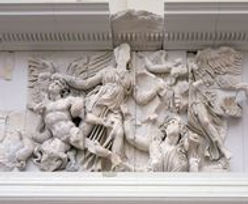
Ancient Greece
Greek Art Study Guide
KEY IDEAS
-
Greeks are interested in the human figure and the idea of perfection.
-
Greek Temples provide a foundation for European architecture and reflects the idea of obtaining perfection with mathematical ratios.
-
The Greek time period starts at around 900 BCE, about 200 years after the collapse of the Mycenaeans.
-
In the 5th century, the Greeks defeated the Persians, though it left Athens in ruins (rebuilt by Pericles) = Start of the Classical time period
-
Polykleitos's canon of proportions: The head should be 1/7 of the body. The chiastic stance that expresses the alternating relaxed and stressed muscles.
-
The Peloponnesian War in 432 BCE (lasted about 27 years) devastated and crushed Athens by the victorious Spartans = Start of the Hellenistic
-
Alexander the Great took over and united the Macedonians with the Greeks in the 4th century and after his death, his empire gave into Roman rule.


THE HUMAN FIGURE FOR THE GREEKS: OBTAINING PERFECTION
ARCHAIC
550 BCE- 6th c.
Artists: ???
Artworks: kouroi and korai
Descriptions: Idealization, stylized, FRONTAL, rigid
SEVERE
480 BCE- 5th c.
Artists: Kritios
Artworks: Pedimental sculpture of the Temple of Aphaia and the Temple of Artemis, Kritios boy
Descriptions: Contrapposto, movement
CLASSICAL
450 BCE- 5th c.
Artists: Phidias, Polyklitos, Myron
Artworks: Riace warrior, Zeus/Poseidon, Doryphoros, Diskobolos, Nike Adjusting her Sandal
Descriptions: Idealization, contrapposto, unemotional,PERFECTION, self-contained
LATE CLASSICAL
350 BCE- 4th c.
Artists: Praxitiles, Scopas,
Lysippus
Artworks: Aphrodite of Knidos, Hermes and the Infant Dionysus, Apoxyomenos, Farnes Herakles
Descriptions:
NATURAL, humanized, relaxed, elongation
HELLENISTIC
250 BCE- 3rd c.
Pythokritos, Polydorus, Agesander, Athenodorus
Artworks: Dying Gaul, Nike of Samothrace, Barberini Faun, Seated Boxer, Old Market Woman, Laocoon and his Sons
Descriptions:
EMOTIONAL, dramatic, exaggeration, movement, individualistic
FRQ
Just over 100 years separate these two statues. Identify these statues and their dates and compare and contrast the ways in which the human body is shown in these two sculptures.


FRQ
The Images below show the Great Altar of Zeus at Pergamon
and a detail of Athena Battling Alkyoneos.
Describe the scene taking place on the frieze.
Why has this scene been placed on this monument?
What contemporary events are paralleled in the scenes depicted in this work?
What is the message this scene was meant to convey to the ancient Greek viewer?





Artwork List
Geometric:
Funerary Krater
Archaeic:
#27 Anavyos Kouros
#28 Peplos Kore from the Acropolis
Severe:
Kritios Boy
Etruscan:
#29 Sarccophagus of the Spouses
#31 Temple of Minerva and sculpture of Apollo
#32 Tomb of the Triclinium
Classical:
#33 Niobides Krater
#34 Doryphoros (Spear Bearer)
#35 Acropolis
- Plaque of the Ergastines
- Victory Adjusting her Sandal
#36 Grave Stele of Hegeso
Hellenistic:
#26 Athena Agora
#37 Winged Victory of Samothrace
#38 Great Altar of Zeus and Athena at Pergamon
#39 House of the Vetti
#40 Alexander Mosaic from the House of Faun, Pompeii
#41 Seated Boxer




















